The Ice Lake Benchmark Preview: Inside Intel's 10nm
by Dr. Ian Cutress on August 1, 2019 9:00 AM EST- Posted in
- CPUs
- Intel
- GPUs
- 10nm
- Core
- Ice Lake
- Cannon Lake
- Sunny Cove
- 10th Gen Core
System Results (15W)
When testing a laptop system, there are various angles to consider on how to test: either user experience benchmarks, that are mostly single threaded and give a good boost to how systems implement a deal of turbo, or sustained benchmarks that test how the system performs when you push it. Intel has gone out of its way to emphasise the former for the next generation of mobile CPUs: they would prefer that reviewers stick to very user experience-like tests, rather than say, rendering programs. The problem there is that outside a number of canned benchmarks, it can be difficult. Users, and especially creators, that typically spend a lot on a premium device, might actually be doing sustained benchmarks.
Given the time that we had to test, we were actually limited in what we could arrange.

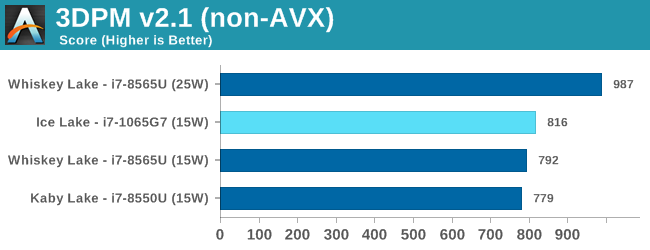

On AVX-512, the Ice Lake part destroys the competition.
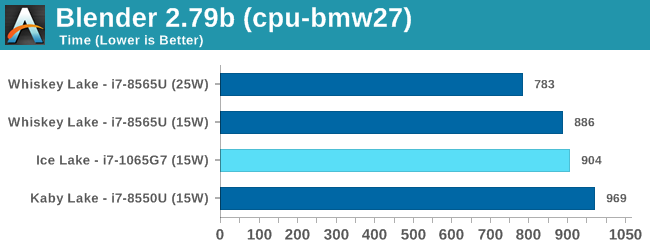
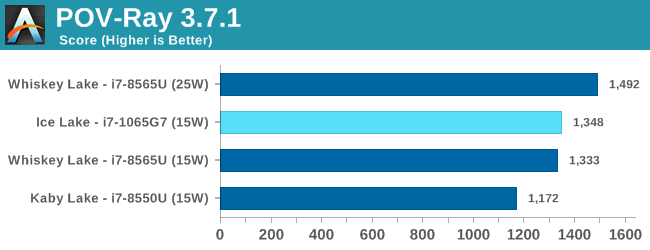


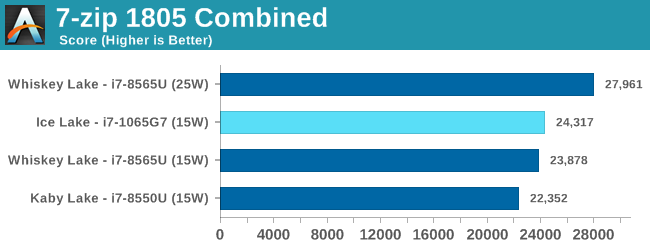
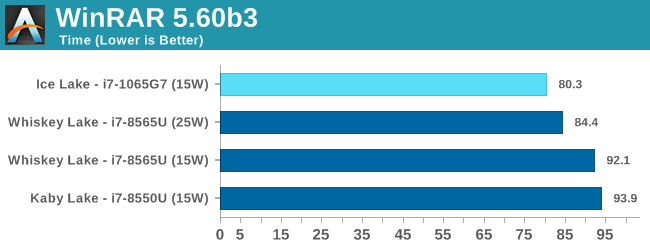
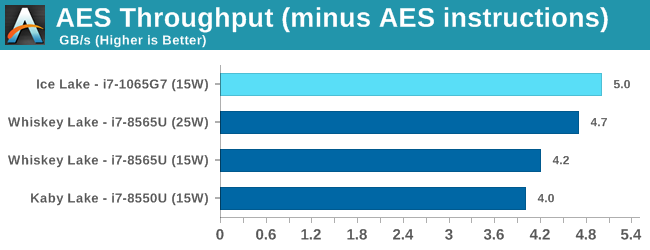
These last two tests are typically our more memory sensitive tests, and the LPDDR4X-3733 really does win out over the LPDDR3-2133 in the other systems.










261 Comments
View All Comments
Phynaz - Friday, August 2, 2019 - link
What? TDP doesn’t mean what you think it does.Alexvrb - Monday, August 5, 2019 - link
I didn't feel like quoting the entire paragraph. But please DO elaborate. Then tell me how useful TDP is when they let OEMs set PL2 and Tau to... anything, really. You can take two "95W" processors and their power and thermals under load are radically different across a range of mainboards. The is reflected in mobile as well, where they let OEMs do pretty much whatever - the results aren't constrained by the processor no matter what the claimed TDP is. That doesn't even COUNT overclocking.Meanwhile AMD chips don't hand over control to mainboards unless you ARE overclocking, which is how it SHOULD be.
Alistair - Friday, August 2, 2019 - link
I didn't see any discussion or comparison vs. the i7-9850H. Let's see a 28W TDP version of the 6 core i7-9850H put against these new chips. Same money, 50 percent more cores. Anyone in their right mind should be looking for an i7-9850H or 9750H laptop instead over these 10nm products. Where is the 6 core 10nm CPU? Don't buy a 4 cores laptop if you're looking for good performance in 2019-2020 imo.If you want a 4 core laptop get a cheaper 14nm based laptop. If you want performance get a 6 core. I really really don't see the point in these products.
Alexvrb - Friday, August 2, 2019 - link
They gotta do *something* with all those 10nm wafers. Ian can't eat them all, and China said they don't want any more half-baked 10nm products after the last go-around. Maybe in 2020 we'll see 10nm++ and it will be as good as phase one 10nm was supposed to be.But yeah, their current 10nm products are a bit disappointing outside of the fatter GPUs and better memory speeds. If you're using something with a dGPU there's little point vs their own 14++, it only starts to make sense if you want AMD-like iGPU performance with the latest Core processor design. Even then that's only limited to models with a high EU count (48+) as the 32 EU models just look meh.
They're going to have some stiff competition when 7nm Zen 2 APUs launch. I guess that's why they're attacking the low-power first, as AMD is still stuck on 12nm rehash Zen+ products for now.
InvidiousIgnoramus - Friday, August 2, 2019 - link
I still find it amusing that the architecture with "Ice" in it's name has low clock speeds presumably from power/heat issues.abufrejoval - Friday, August 2, 2019 - link
Great work! And kudos to AMD to make Intel work so much harder to get good news out!Two die carrier layouts but the chips looking identical:
First of all, I assume that the bigger and square chip is essentially the North-Bridge in 14nm?
And the smaller rectangular one the CPU+iGPU?
And I guess at 64EU we are talking about more than 60% of die area going to iGPU while even at quad core and AES-512 the CPU + cache will be perhaps 30%?
Is there any HSA or GPGPU compute to 'pay' for that iGPU surface and power in professional workloads?
Or is it really just for gaming?
Am I also correct to assume that of the extra thermal budget in the 28Watt parts, none really goes to the CPU, only allows it to stay within the 15 Watt envelope while the iGPU is also running?
Are we talking different die layouts and sizes for dual/quad CPUs and 64/32 iGPU EUs or is it really all just binning, meaning that an Core i3-1000G1 is a chip where 70% surface area of an Core i7-1060G7 failed to make it?
Why am I thinking they are heading down a path without consumer value returns?
I got a Lenovo S730 i7-8565U or Whisky Lake recently for a little over €1000 and I got a couple of J5005 Atoms recently for a little over €100 (admittedly complete notebook vs. RAM less Mini-ITX mainboard). The difference in power is 15 vs 10 Watts.
Both are fairly competent 2D machines even at 4k. Both are terrible gaming machines, but I don't really think that ultrabook portable gaming performance is a selling point.
If I were free to choose CPU vs. GPU real-estate, I'd definitely go left, say 6 or 8 CPU cores or just higher sustained turbos and make do with the J5005's 18 iGPU EUs, because CPU power is what I profit from professionally.
For GPU, every € I spend gets me vastly more gaming experience in less mobile form factors, which is fine: I don't see how I could run in a game and outside without breaking my newest toy.
Sahrin - Friday, August 2, 2019 - link
$426 for a quad core in 2019. What a time to be alive.eva02langley - Friday, August 2, 2019 - link
So basically... expensive, low yield, 4 cores, low frequency.Outside of better IGPU, barely matching AMD offering, and AVX512, which is not even a matter for a 4 cores CPU, 10nm is an abysmal failure.
Phynaz - Friday, August 2, 2019 - link
So basically....you’re an imbecileKorguz - Friday, August 2, 2019 - link
your one to talk phynaz, i guess you want to be stuck on quad cores in notebooks for ever ???